Ever since I wrote Something Wicked, with its climax in Brompton Cemetery, I’ve enjoyed London graveyards and, of course, I’m always up for anything Napoleonic. Last weekend I was able to combine the two interests with a tour of Kensal Green Cemetery looking at tombs linked to the Napoleonic Wars, followed by a talk and demonstrations of musket fire and Regency dancing.
The first tomb we visited was that of the Brunel family.
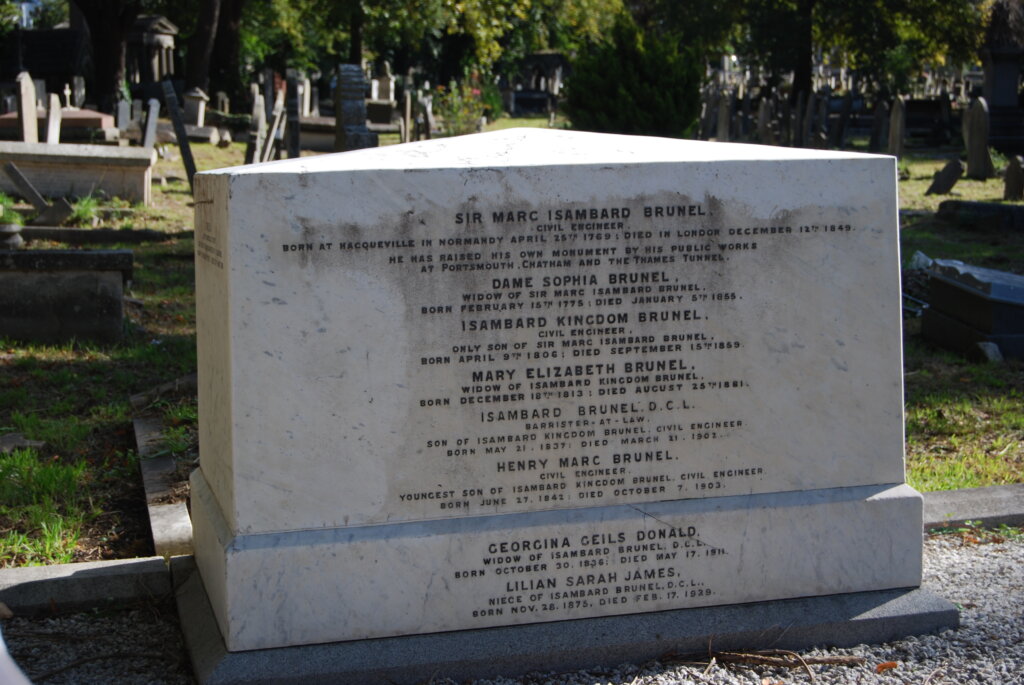
We weren’t there to honour the memory of Isambard Kingdom Brunel whose work we had admired recently in Bristol. We were there to pay our respects to his father, Sir Marc Isambard Brunel.
Sir Marc was born in France but, as a Royalist, he had to flee the country during the reign of terror. He went to the USA, where he built a successful career as an engineer. When he learned, though, that the Royal Navy was handicapped in its fight against Napoleon by the difficulty in producing the 100,000 pulley blocks a year needed to supply its ships, Sir Marc travel to England with plans to develop machinery that would produce pulley blocks more efficiently than the handcrafted blocks made up until then. By 1808, his factory was producing 130,000 blocks per year, a significant contribution to the war effort. Later, when the condition of soldiers’ boots became a national scandal, Sir Marc developed machinery to produce higher quality boots. Given that soldiers had often been marching on boots which had literally fallen apart, this, too, contributed toward Britain’s military success.
There were a few other civilian graves, but most of those we saw were soldiers. Of most interest to me was the tomb of Sir John Waters. Waters was one of Wellington’s Exploring Officers in Spain, a noted linguist and a useful spy. Some of Burke’s adventures in Burke in the Peninsula are based on the real-life escapades of Sir John. He died in 1842, aged 68.
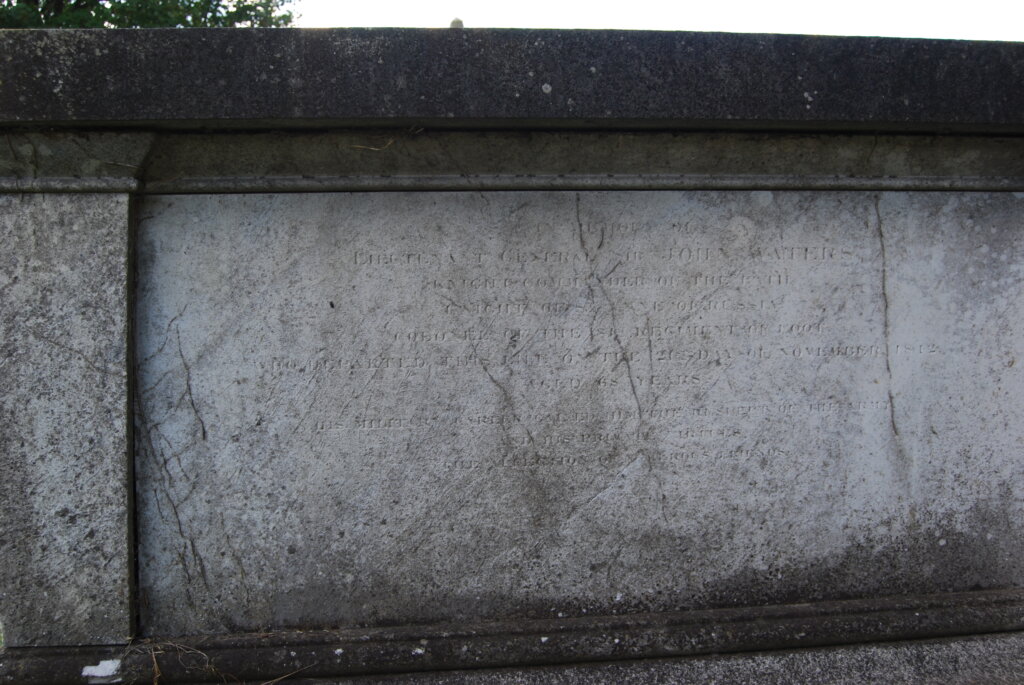
There were some splendid military graves marking the burial site of unknown soldiers and thus not included in our official tour, but the stones are too magnificent to ignore. I particularly liked this one.
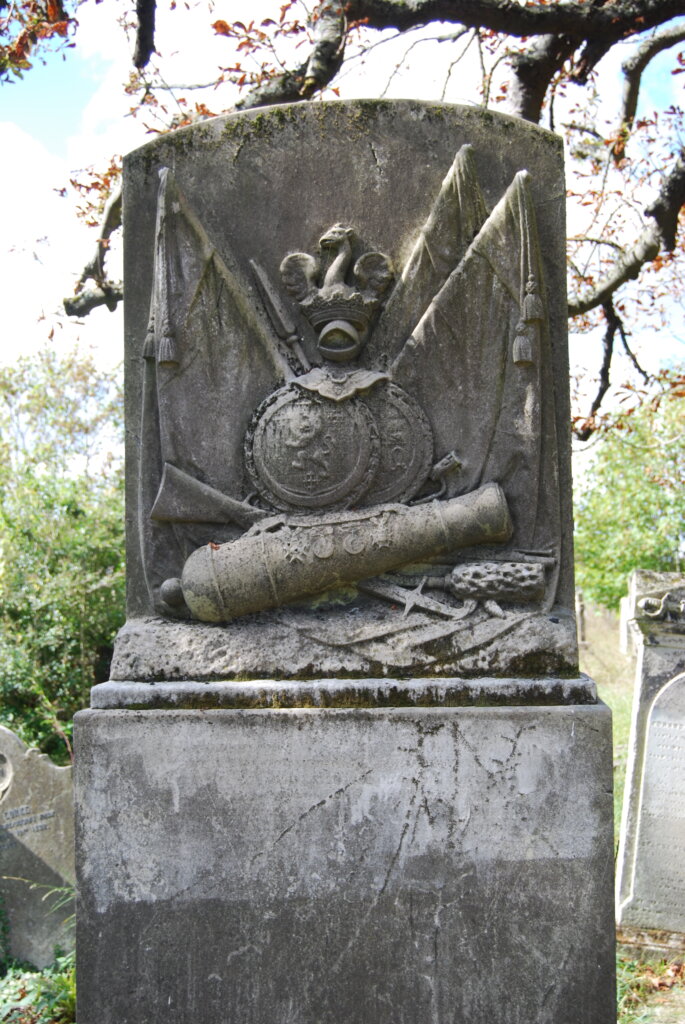
No tour of a Victorian cemetery is complete without a visit to the catacombs. Sadly, the condition of the catacomb burials we saw at Kensal Green was not nearly as good as at Brompton Cemetery. Under the Dissenters Chapel, most of the catacombs (basically giant pigeon-holes) are empty with the few remaining coffins wrapped in polythene as the contents threaten to spill out and then tucked away behind a locked door.
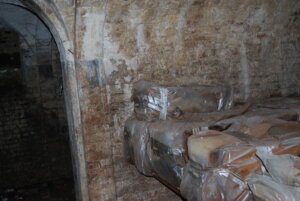
After our tour of the graves, with fascinating anecdotes about the people buried there, we were given talks on the Napoleonic Wars generally and the Battle of Waterloo in particular. Then came a treat as we were presented with a demonstration of musket/rifle drill. (One musket and one rifle.) There were several impressively loud bangs and a great deal of white smoke.
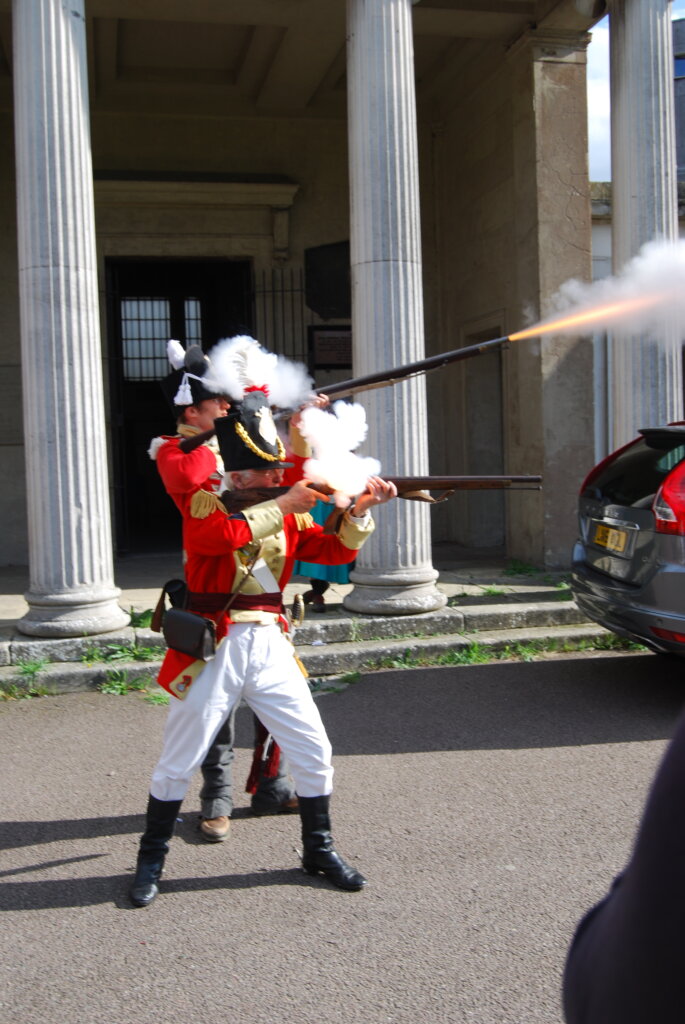
Survivors faced a bayonet charge.
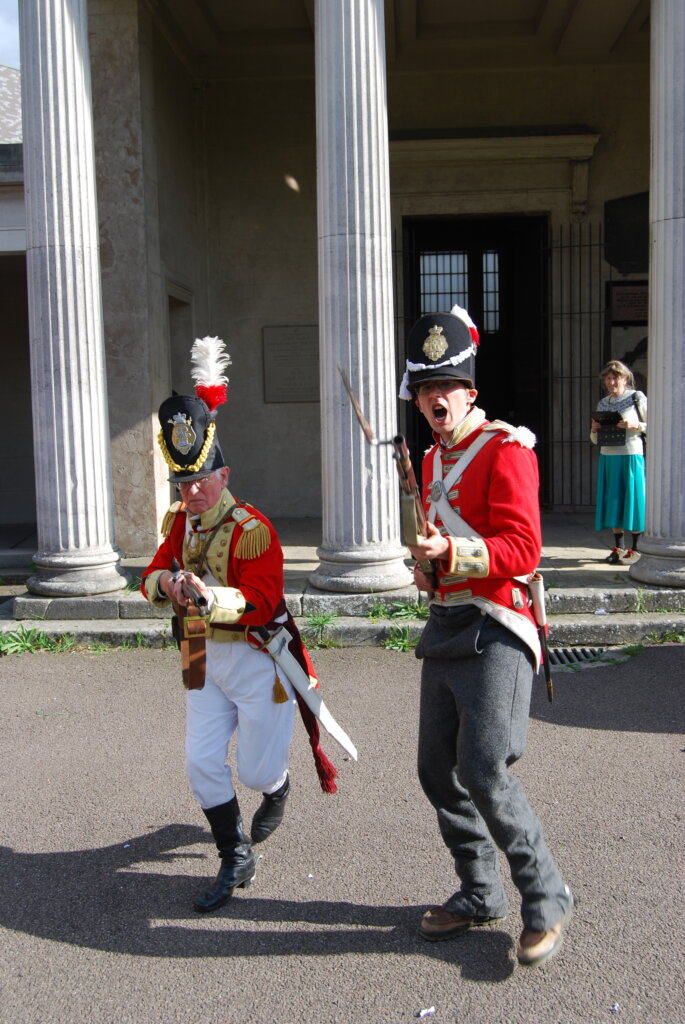
After the battle, a few brave souls joined in a demonstration of a waltz of the period. The modern waltz not yet being in fashion, we were treated to something that looked more like a country dance, complete with a caller to make sure people took the right steps. It looked quite unlike any dances I have seen in Jane Austen films, though I suspect it was closer to reality (or would have been once people had more time to practice).
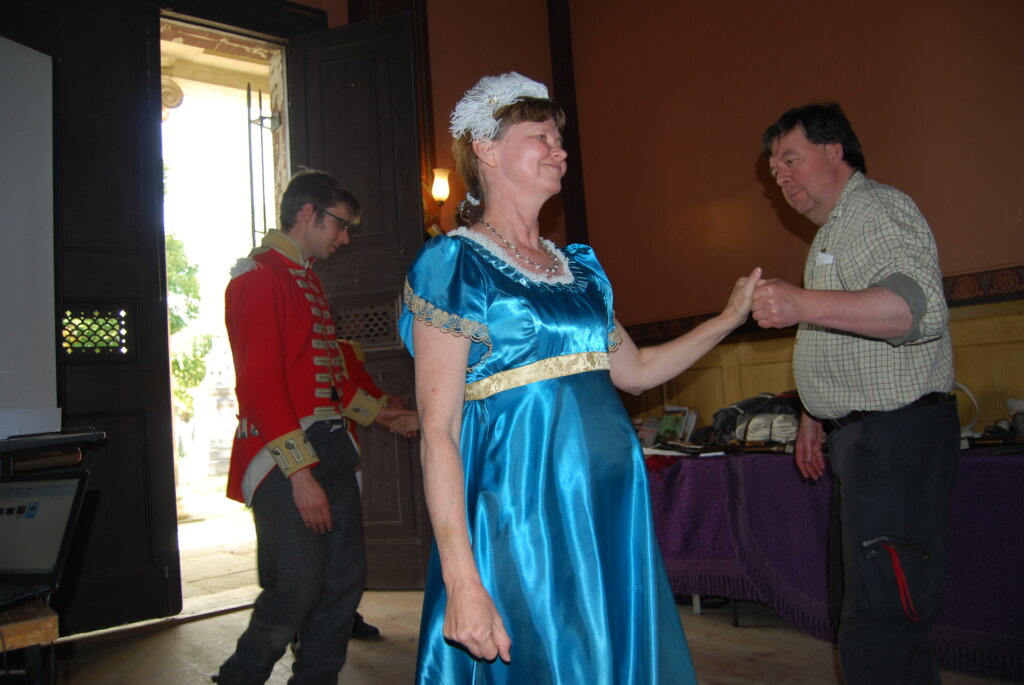
The dancing was followed by a display of the kit carried by soldiers at Waterloo. The basic kit bag was less heavy than I had expected (considerably less heavy than a soldier carries nowadays) but that was without the water bottle and the canvas bag containing the day’s rations. The musket or rifle (depending on regiment) was very heavy, as was the cartridge box filled with lead balls
We were, of course, handling all this in the dry. There was no proper waterproof clothing and the greatcoats, made of wool, will have become steadily heavier if worn in the rain. Until quite late in the war, backpacks were rolled up with no protection against rain at the sides, so blankets, too, will have become soaked and heavy. When you remember that there were no tents for private soldiers and that they would shelter under their blankets, the weight of the packs after a wet night does not bear thinking about.
There was a waterproof cover for headgear. The man may be wretched and soaked, but his shako will always have looked smart. Officers of the Napoleonic era clearly knew what mattered.
There was also a waterproof cover for the firing mechanism of the gun – the black patch in the photo below.
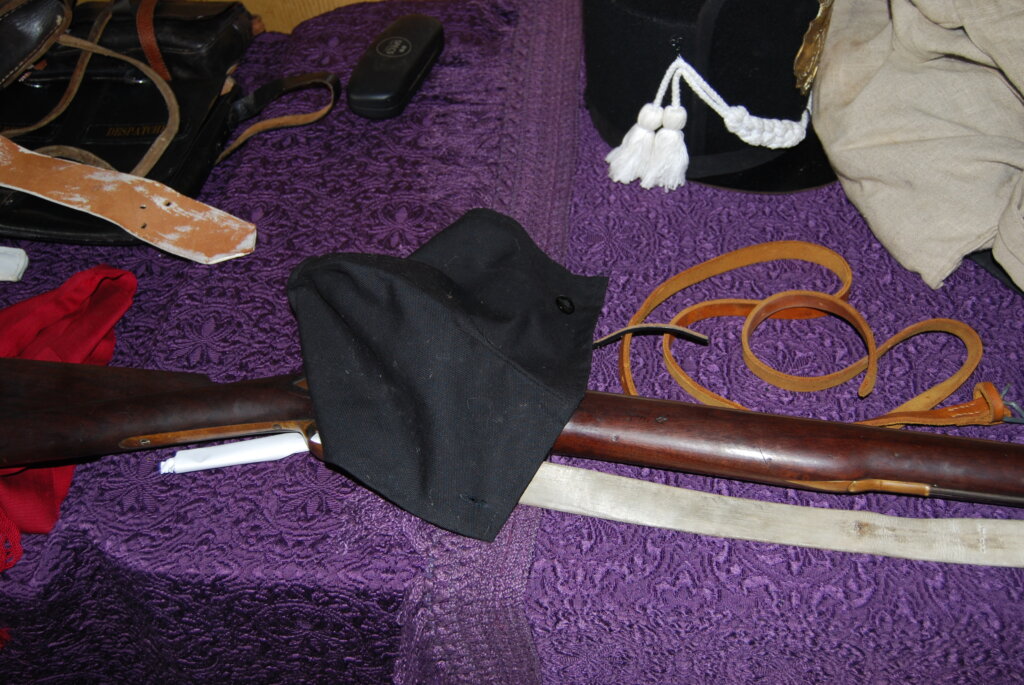
Looking at all the items the soldier carried gave a vivid picture of the vicissitudes of military life. A demonstration of striking a flint (you can see flint and steel at the bottom centre of the picture below) showed it’s not nearly as easy as they make it look on TV. In fact, you can’t get a spark big enough to light wood, so you have to carry char-cloth (literally charred cloth) to get started. That’s what’s in the little round box sat above the flint and steel.
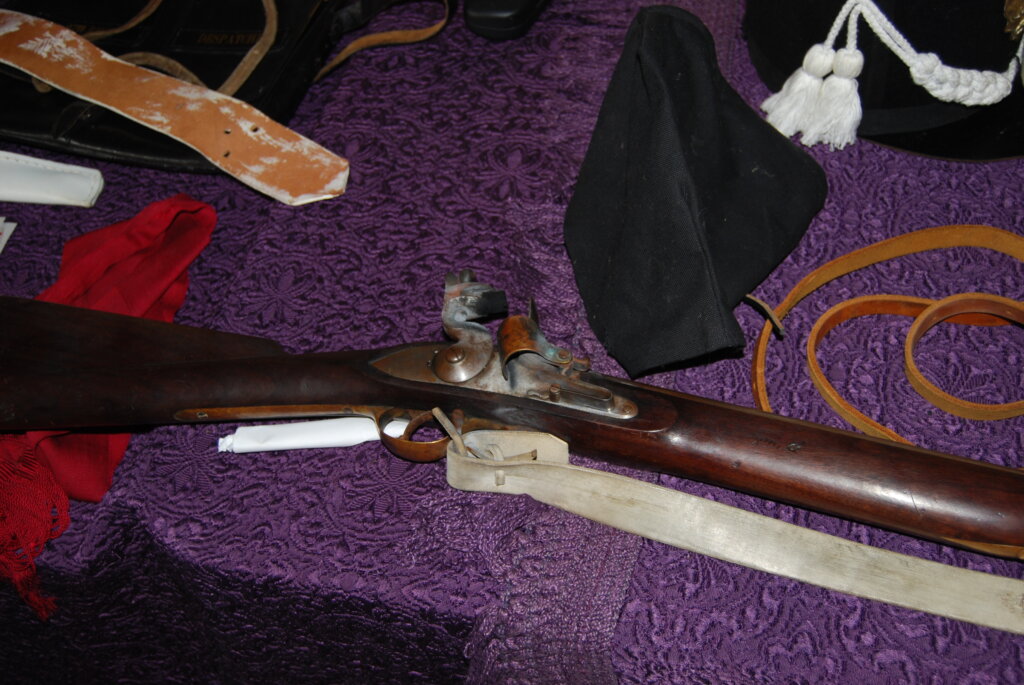
Getting a fire started was essential if you planned to eat. Your salt beef and biscuit were inedible until they had been boiled in water. At least by 1815 you had your own tin mess tin (on the left, next to the bag) rather than sharing a big metal kettle that had to by carried by each group of mess-mates.
No wonder that even a hundred years later, Christopher Robin’s nanny explained to him that “A soldier’s life is terrible hard.”
A Word from Our Sponsor
It was lovely to take a day off and go back to the world of Napoleonic history because I’ve been lately been lost in a more contemporary fictional world of vampires and policemen as I finish the latest Galbraith & Pole book, Monsters in the Mist. The final edits have been made and the formatting has been finished , so we are on schedule for publication at the end of October. Next week I’ll be revealing the cover and telling you a little about the book.

I’m glad you enjoyed it.
We’re aiming for more special tours, and there are many more Napoleonic Stories at Kensal Green Cemetery.
Even though an inscription may be unreadable, that doesn’t mean we don’t know who is buried there. The memorial with the flags that you show is to Sir Henry King (c.1777-1854).
He was in Egypt with the 26th Light Dragoons where he lost a leg. In 1807 he joined the 82nd Foot as a Major and was at Walcheren in 1809. He commanded the 82nd Foot at Burgos and Vitoria.